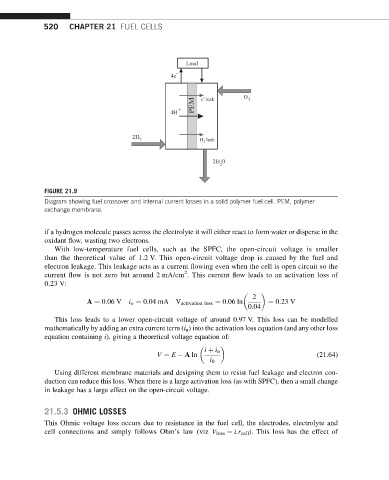Page 527 - Advanced thermodynamics for engineers
P. 527
520 CHAPTER 21 FUEL CELLS
Load
-
4e
-
PEM e leak O 2
4H +
H leak
2H 2
2
2H O
2
FIGURE 21.9
Diagram showing fuel crossover and internal current losses in a solid polymer fuel cell. PEM, polymer
exchange membrane.
if a hydrogen molecule passes across the electrolyte it will either react to form water or disperse in the
oxidant flow, wasting two electrons.
With low-temperature fuel cells, such as the SPFC, the open-circuit voltage is smaller
than the theoretical value of 1.2 V. This open-circuit voltage drop is caused by the fuel and
electron leakage. This leakage acts as a current flowing even when the cell is open circuit so the
2
current flow is not zero but around 2 mA/cm .Thiscurrent flowleadstoanactivationlossof
0.23 V:
2
A ¼ 0:06 V i o ¼ 0:04 mA V activation loss ¼ 0:06 ln ¼ 0:23 V
0:04
This loss leads to a lower open-circuit voltage of around 0.97 V. This loss can be modelled
mathematically by adding an extra current term (i n ) into the activation loss equation (and any other loss
equation containing i), giving a theoretical voltage equation of:
i þ i n
V ¼ E A ln (21.64)
i 0
Using different membrane materials and designing them to resist fuel leakage and electron con-
duction can reduce this loss. When there is a large activation loss (as with SPFC), then a small change
in leakage has a large effect on the open-circuit voltage.
21.5.3 OHMIC LOSSES
This Ohmic voltage loss occurs due to resistance in the fuel cell, the electrodes, electrolyte and
cell connections and simply follows Ohm’s law (viz V loss ¼ i.r cell ). This loss has the effect of

